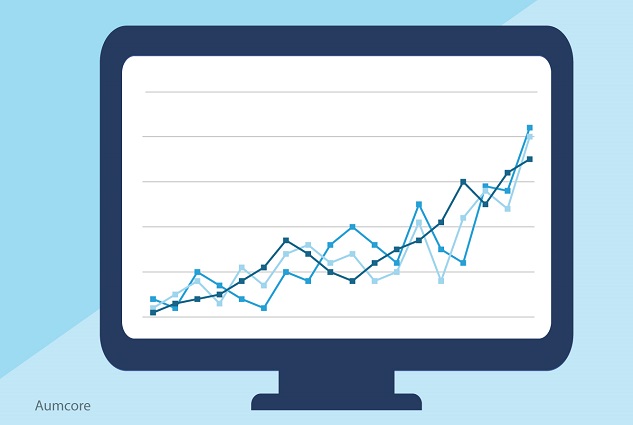| One of the beauties of living in the modern world is the amount of data we have at our disposal. Whether it’s from browsing or purchasing behaviour, device usage, social interactions or the countless other sources out there, we now have access to big data and the near limitless insights we can glean from it. And because the vast majority of this data comes from the personal habits and behaviours of the consumers we seek to sway, strategies derived from it can lead to valuable insights and improved decision making for companies seeking to grow.
It boils down the fact that, as a hallmark of marketing, data gives you an encompassing view of both your business and its audience. For example, the knowledge that your users prefer communicating with one medium over another can lead to better tailored strategies with a higher chances of success. Why? Because you have data backing it up telling you that this works better than that, and that doing that over this would be more beneficial. The Benefits of Data-Driven StrategiesFrom what we briefly covered above, you can gather that data-driven strategies come with many benefits that can help businesses grow. For instance, by tracking information like best and worst performing products, you can modify your inventory to include more of the former and less of the latter, which serves to cut costs (less leftover inventory) and increase revenue (more sales from the popular products). Similarly, you can use tools like Google Analytics to know things like who you should be targeting, who, from that group, has the highest probability of converting, when you should reach them as they go through the sales funnel, how to reach them, such as which channels work best and which are better being left alone, and a myriad of other things that all contribute to your bottom line, which determines how much you can grow. In the same vein, data-driven strategies allow you to identify opportunities you can exploit, such as whether or not to make a certain investment or develop one product over another. For example, let’s use a simplified analogy to better illuminate this point. Imagine you’re a digital marketing agency and are about to redesign your website to better showcase your offerings — your current decision revolves around choosing whether to highlight your Magento or Drupal capabilities. If you see that more and more of you past clients opted for Magento over Drupal, it wouldn’t make sense to ignore that preference and create a web development landing page featuring Drupal. Instead, you would use what you learned from your data, that more and more businesses are choosing Magento, and tailor the page specifically for it. Putting all of this together, we arrive at the conclusion that data-driven strategies give you all you need to better predict behaviour and use that information to your advantage. The question now becomes, how can I build such a strategy? How to Build a Data-Driven Marketing StrategyBuilding a data-driven strategy isn’t as hard as you may think. As this post explains, everything you need to do can be summed up in three steps:
With that in mind, let’s get started. Step 1: Set-Up GoalsBig data means exactly that — a lot of data coming in from multiple sources that’s begging to be used. The thing is, with so much data on your hands, indecision can set in. Should you try to accomplish this, or should you focus on that? For this very reason, you have to decide on which goals you want to pursue before you ever start collecting data. In other words, while all data is useful — there’s no doubt about that — you won’t use all of it, and collecting/analysing it will be a waste of time and resources. Delving deeper, make sure to set concrete and achievable goals that build up on one another. That is to say that if your overall goal is to increase conversions by X percentage, you’re not going to get there at once. Instead, do it incrementally by setting up smaller goals within that overarching goal. After this, set up a system that ensures you’re always making progress toward your goals. Rewinding a bit, don’t make the all-too-common mistake of focusing solely on your vanity metrics, such as social followers, page views, site visitors, subscribers and others that, while work to paint a pretty picture of your brand, don’t really offer anything substantive — e.g., if you have a spike in site visitors, but no spike in conversions, does that first spike really matter? Alternatively, focus on revenue ad engagement metrics that actually add to your bottom line, such as the bounce rate, time on site, conversion rate and abandonment rate. These metrics actually help you understand how you’re doing, how your users are engaging with you and the impact of your email marketing efforts. Step 2: Collect DataWith goals in place, it’s time to collect data and get the ball rolling. As we mentioned earlier, data comes from many, many sources. You have surveys, transactional data, social media interactions, purchasing and browsing behaviour, and quite a few other sources that can all feed data into your strategies. Thankfully, you now have goals to lend you a hand as you whittle down on everything, and a variety of tools you can use: Content Analytics Tools ● Ahrefs Content Explorer ● BuzzSumo ● SpyFu Customer Analytics Tools ● comScore ● Crazy Egg ● Facebook IQ Audience Insights ● SurveyMonkey CX ● Webtrends Email Marketing Analytics Tools ● MailChimp ● Pardot Social Media Analytics Tools ● Buffer ● Hootsuite ● Mention ● Sprout Social Traffic-Oriented Analytics Tools ● Google Analytics ● Moz Pro ● SEMrush With and even without these tools, you can start collecting data. For example, as they’re already your customers, you have CRM data on-hand you can use. Apart from this, you can use UTM codes and cookie data to track your users’ behaviour as they navigate to and from your site, such as click-throughs, traffic and bounce rates. You can also analyse your customers’ real time behaviour to get a good idea as to how they behave and interact with you. For example, you can study how long they spend on your site and the different pages they visit as they move throughout and look at what you have to offer. Step 3: Appraise Data and Use ItSep 1: done; step 2: complete; it’s time for step 3, which is reserved for analysing, appraising and using data. Like collecting data, how you use it depends on the goals you set up earlier. For example, if you plan on advertising a new product, you would use some customer analytics and traffic-oriented tools to see who would respond best to it and where to place the ads for the highest impact. If you’re rolling out a new service, you would use email marketing tools to know the optimal time to email your users letting them know about that service. Along the same lines, your data also tells you what’s going on with your different endeavors. For instance, if you’re regularly posting blog posts as part of your content marketing strategy, your metrics tell you: ● Pageviews: the total number of times your post has been viewed ○ A low number tells you that few people are landing on your post, which can mean your title needs to be optimised so your audience is intrigued enough to read it. ● Average session: the average time spent on your post by your readers ○ A disparity between certain posts’ average session tells you a couple of things. For example, if post E is three minutes and posts A through Dare between seven and nine minutes, you know that your audience either prefers the content from A-D, or that something fell short with E. If you’re fine-tuning your social media strategy, your metrics tell you: ● Shares: shows you how well your posts resonate with your audience ○ If you have a lot of shares, you know your audience likes your content and wants their friends/family to do so as well. ● Comments: how many comments your audience are leaving on your posts and what they’re saying ○ Reading over your comments is an excellent way of knowing how engaging your content is. Additionally, comments tell you exactly what your audience thinks of your content. If you’re in the middle of a paid marketing campaign, your metrics tell you: ● Click-through rate: the percentage of people who clicked on your ads and arrived at your landing page ○ Your CTR tells you how effective your ads are; a high CTR means that people are clicking on them and a low CTR that they are not. ● Bounce rate: the percentage of site visitors who clicked (bounced) out shortly after landing ○ A high bounce rate tells you that, while your ads are attracting visitors, your landing page isn’t delivering on what you promised. It can also tell other things, such as that your site takes too long to load and they decided to leave without taking further action. The more metrics you track and data points you have, the better your insights can be and the actions you take with them. You can also make certain decisions that can improve your business, such as whether to create new submarkets for your products or services if you find that there’s an opportunity to move into a new niche or audience. Final ThoughtsWhatever your goals are and whatever you’re trying to accomplish, using data-driven strategies guarantees a higher level of success because you have exactly what you need to make them work: data. This is because the more you know about how your business is doing and how your audience behaves, the better you can predict your next move’s outcome. Good luck! |
| Author Bio: Sabrina is a content writer for Appnova, a creative digital agency based in London that specialises in luxury branding. She writes on a variety of topics that range from search engine optimisation (SEO) and mobile app development to the many wonders of artificial intelligence (AI). |
Author Profile
- I'm the CEO of ClickDo Ltd. and SeekaHost- I help the business grow online with latest SEO services & digital marketing strategies.
Latest entries
 Business StrategiesFebruary 25, 2021How to Start A Business In The UK (10 Steps to Starting & Build A Company)
Business StrategiesFebruary 25, 2021How to Start A Business In The UK (10 Steps to Starting & Build A Company) EntrepreneurshipMay 27, 2019How to get business visa for UK (What you must know about UK Entrepreneur visas)
EntrepreneurshipMay 27, 2019How to get business visa for UK (What you must know about UK Entrepreneur visas) Business TipsMay 21, 201911 Ways To Create A Self-Sufficient Business That Runs Without Making The Owner A Slave To It
Business TipsMay 21, 201911 Ways To Create A Self-Sufficient Business That Runs Without Making The Owner A Slave To It EntrepreneurshipMay 18, 2019The Madness of Steve Jobs Told by Steve Wozniak
EntrepreneurshipMay 18, 2019The Madness of Steve Jobs Told by Steve Wozniak





